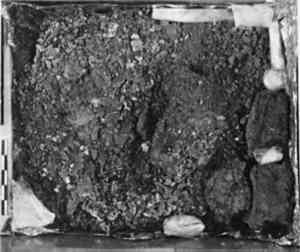FROM CODEX TO CALABASH: RECOVERY OF A PAINTED ORGANIC ARTIFACT FROM THE ARCHAEOLOGICAL SITE OF CER�N, EL SALVADORHARRIET F. BEAUBIEN
3 LIFTING AND TRANSPORTThe archaeologists removed the deposit from the niche by sliding a metal sheet along the adobe floor (fig. 2). No subsidiary support was provided around its fragile edges either during the lift or subsequently during
The paint layer was removed using a block-lifting technique. Allowing a margin of at least 2 cm on all sides, a shallow trench was cut into the floor so that a metal sheet could be slid 3 cm below the floor surface. While necessarily damaging the niche floor, this method resulted in no disruption of the remnant paint layer. The lifted section was set into an aluminum foil-lined cardboard box, and plaster of Paris was poured around the perimeter to prevent any subsequent movement of the adobe block. The paint fragments were then cleaned with a soft paintbrush and, once tested for sensitivity to water and organic solvents, retained in position with small strips of tengujo Japanese tissue and Dow Methocel A15C methyl cellulose in water. Given the rarity of the find and the lack of instrumentation and expertise in El Salvador to carry out a thorough investigation, a cooperative agreement for temporary transfer to the United States was signed, and the two components were packed and hand carried to the Smithsonian Institution's Conservation Analytical Laboratory (CAL). In time, the artifact would be safely mounted for return to the Museo Nacional David J. Guzm�n in San Salvador. Protection in transit was provided as follows. The “multilayer component” (lifted by the archaeologists) was transferred from its plastic bag to a fitted foil-lined cardboard box. Small pillows of Saran Wrap covered cotton wool and Ethafoam blocks were used along the sides to pad the deposit in position, and the surface was protected with a layer of Pellon overlaid with cotton wool. The box was then enclosed in a plastic bag to maintain its high humidity. The “single-layer component” (lifted by the author) was similarly padded on its surface but did not require bagging, as it had been allowed to air-dry. Each component was cushioned within a wooden carrying box using blocks of Ethafoam and rolled bubble wrap. The boxes were maintained in their horizontal orientation during their transport to CAL. |
